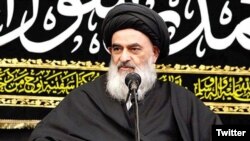Two groups of religious vigilantes on Monday tried to force their way into important shrines in Iran that were closed to the public as a measure against the spread of coronavirus.
One group consisted of pro-Khamenei zealots, the other of fanatical followers of a dissident anti-regime cleric. The incidents have caused a huge scandal with the pro-Khamenei side now being forced to publicly repent.
The protesters who believe the shrines have great healing powers, charged that the government was following "anti-religion advice of the World Health Organization".
Before it became too obvious that pro-regime fanatics were involved in the incidents in the shrines, the regime media tried to use these incidents and similar instances of religious zealotry to launch another massive propaganda attack against Ayatollah Seyed Sadiq Hussaini Shirazi, a controvercial Qom-based cleric known for refusing to acknowledge Khamenei's religious and political authority.
The official media called the protesters "extremists" and "transgressors" that had to be contained and even punished.
A pro-regime cleric addressing a mixed sit-in of pro-regime and dissident protesters against the closure of the Shrine of Masoumeh in Qom.
The same media and regime insiders, however, had failed to voice any opposition when regime clerics such as Ayatollahs Ahmad Alam ol-Hoda, the Custodian of Imam Reza Shrine of Mashhad and Mohammad Saeedi, Custodian of Mashoumeh Shrine in Qom, put up a strong opposition to the government decision to halt Friday prayers due to coronavirus and shrine closures.
Nothing could demonstrate the coming together of the two groups, normally bitter enemies, better than a video of the sit-in at one of the two shrines. The video showed a pro-Khamenei cleric calling on "the Great Leader" to help them keep the shrines open and someone from the other group fearlessly shouting "God's curse be upon him!". He was obviously a follower of Shirazi.
The 78-year-old Seyed Sadiq Hussaini Shirazi who is the target of the attacks is from a well-established and influential clerical family with ties both to Iran and Iraq where he was born. He succeeded his brother Grand Ayatollah Sayyid Mohammad Shirazi in 2001 and is himself a grand ayatollah and source of emulation.
Pro-regime vigilante calling people to protest to the closure of shrines. He has had to publish a video and "repent" from his actions.
The black-listed Ayatollah has never held any office in Iran but the huge religious taxes paid by his followers have enabled him to establish an extensive network of satellite TV channels that broadcast his lectures, religious teachings and political views in Persian, Arabic and English across the Muslim world.
Shirazi has a quite impressive international following in countries such Iraq and Kuwait and also funds various schools and places of worship in other countries including Britain. The regime finds it hard to directly target or suppress Shirazi due to his high clerical rank (he is a source of emulation), and being a descendant of the Prophet (a Seyed), as well as the size of his following in Qom and Mashhad, the two religious cities of Iran, and his great influence among Iraqi Shiites.
The pro-regime clerical establishment and propaganda bodies allege that Shirazi and his followers take their orders from the government of Britain. In Iranian hard-liners' media they are always referred to by the idiosyncratic title "English Shiites" in an attempt to evoke aversion of Iranians to the historical meddling of Britain in Iranian affairs. The group, in turn, call Khamenei's followers "Russian Shiites" in reference to historical rumors that Khamenei lived and studied in Russia in his youth and is a Russian crony.
In some ways the religious behavior of Ayatollah Shirazi's followers is even more fanatical than the pro-regime vigilantes. They advocate bloody self-flagellation in religious ceremonies such as Ashura; something Khamenei and most other Shiite sources of emulation in Iran have banned. The practice of slashing heads with sabres during Ashura is actively suppressed by Iranian regime security forces, mostly because it is against Khamenei's edicts.
The followers of Shirazi are also very aggressive in their anti-Sunni propaganda and often provoke Sunnis in Iran and across the world with insults to Sunni sanctities. The London-based Yassir al-Habib, a Kuwait-born Shiite cleric, is famous for provocation of Sunnis on Shirazi-funded television channels by preaching that the Prophet Mohammad was killed by his wives Aisha and Hafsa and successors Abu Bakr and Omar. To Sunnis these allegations are blasphemous.
One of the organizers of the protest against closure of shrines repenting his actions in this video.
This was not the first time zealots challenged government decisions on coronavirus. In early March, they released videos showing they were licking shrine grids to prove that the "holy" sites were immune to the virus.
The defiant act led to anger and criticism by citizens. Pro-regime media and figures used these videos as ammunition against the Shirazi group. In an undated short video the man who started the "shrine-licking challenge" videos and his son are seen sitting next to Shirazi in what appears to be an audience.
However, thanks to social media it has now become crystal clear that the organizers of the protests and sit-ins against shrine closures were too close to home, members of pro-regime clergy and Basij militia. The regime had to somehow deal with the scandal so one of the leaders of the protesters, in true Islamic Republic fashion, has been forced to publish a video in which he repents his "emotional" reaction to the closure of the shrines and professes his obedience and allegiance to the "Great Leader of the Revolution". More confessions will be on the way.








